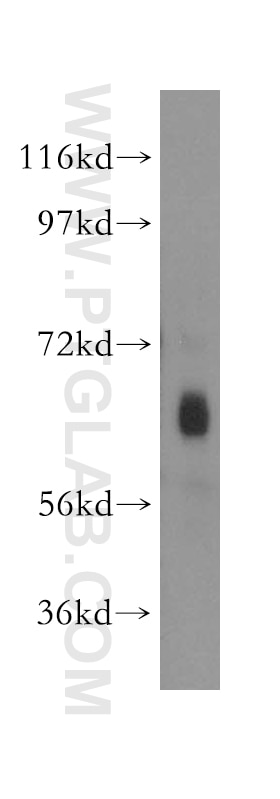Tested Applications
| Positive WB detected in | A549 cells |
Recommended dilution
| Application | Dilution |
|---|---|
| Western Blot (WB) | WB : 1:500-1:2000 |
| It is recommended that this reagent should be titrated in each testing system to obtain optimal results. | |
| Sample-dependent, Check data in validation data gallery. | |
Published Applications
| WB | See 2 publications below |
| IP | See 1 publications below |
| ChIP | See 2 publications below |
Product Information
11226-1-AP targets TH1L in WB, IP, ChIP, ELISA applications and shows reactivity with human, mouse, rat samples.
| Tested Reactivity | human, mouse, rat |
| Cited Reactivity | human |
| Host / Isotype | Rabbit / IgG |
| Class | Polyclonal |
| Type | Antibody |
| Immunogen |
CatNo: Ag1750 Product name: Recombinant human TH1L protein Source: e coli.-derived, PGEX-4T Tag: GST Domain: 242-590 aa of BC014952 Sequence: QAMMSVLAQEEQGGSAVRRIAQEVQRFAQEKGHDASQITLALGTAASYPRACQALGAMLSKGALNPADITVLFKMFTSMDPPPVELIRVPAFLDLFMQSLFKPGARINQDHKHKYIHILAYAASVVETWKKNKRVSINKDELKSTSKAVETVHNLCCNENKGASELVAELSTLYQCIRFPVVAMGVLKWVDWTVSEPRYFQLQTDHTPVHLALLDEISTCHQLLHPQVLQLLVKLFETEHSQLDVMEQLELKKTLLDRMVHLLSRGYVLPVVSYIRKCLEKLDTDISLIRYFVTEVLDVIAPPYTSDFVQLFLPILENDSIAGTIKTEGEHDPVTEFIAHCKSNFIMVN Predict reactive species |
| Full Name | TH1-like (Drosophila) |
| Calculated Molecular Weight | 66 kDa |
| Observed Molecular Weight | 66 kDa |
| GenBank Accession Number | BC014952 |
| Gene Symbol | TH1L |
| Gene ID (NCBI) | 51497 |
| RRID | AB_2201665 |
| Conjugate | Unconjugated |
| Form | Liquid |
| Purification Method | Antigen affinity purification |
| UNIPROT ID | Q8IXH7 |
| Storage Buffer | PBS with 0.02% sodium azide and 50% glycerol, pH 7.3. |
| Storage Conditions | Store at -20°C. Stable for one year after shipment. Aliquoting is unnecessary for -20oC storage. 20ul sizes contain 0.1% BSA. |
Protocols
| Product Specific Protocols | |
|---|---|
| WB protocol for TH1L antibody 11226-1-AP | Download protocol |
| Standard Protocols | |
|---|---|
| Click here to view our Standard Protocols |
Publications
| Species | Application | Title |
|---|---|---|
PLoS Pathog Strength of T cell signaling regulates HIV-1 replication and establishment of latency. | ||
J Biol Chem NELF coordinates RNA polymerase II pausing, premature termination and chromatin remodeling to regulate HIV transcription. | ||
Virology RNAP II processivity is a limiting step for HIV-1 transcription independent of orientation to and activity of endogenous neighboring promoters. | ||
Mol Cell CRL3ARMC5 ubiquitin ligase and Integrator phosphatase form parallel mechanisms to control early stages of RNA Pol II transcription |




